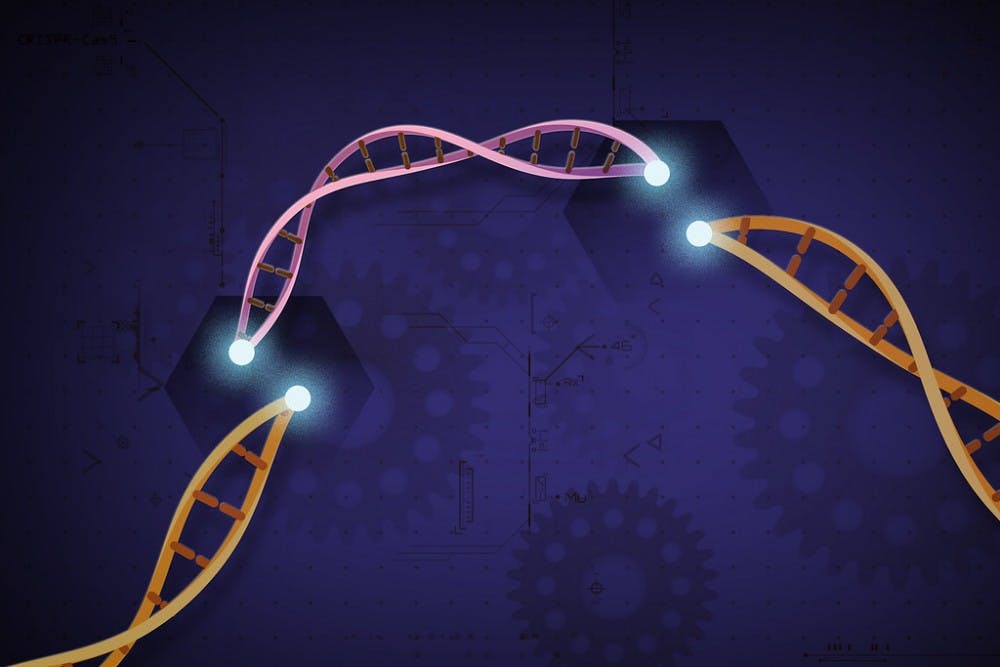Researchers at Cornell University recently developed a novel CRISPR system that has the potential to affect human genes. This research was featured in the paper “Introducing a Spectrum of Long-Range Genomic Deletions in Human Embryonic Stem Cells Using Type I CRISPR-Cas” published in the journal Molecular Cell. The development may, in the future, be able to recognize and destroy viruses such as Epstein-Barr and hepatitis B.
Ailong Ke, a molecular biology professor at Cornell and one of the authors of the paper, described the medical implications of the new CRISPR-Cas3 technology.
“Our tools can be made to target these viruses very specifically and then erase them very efficiently,” Ke said, according to a Cornell-published press release. “In theory, it could provide a cure for these viral diseases.”
CRISPR-Cas3 marks the first time CRISPR, a genetic editing technology, has been implemented to target and delete significant portions of human DNA. CRISPR, short for “clusters of regularly interspaced short palindromic repeats” is a specific component of DNA. CRISPR sections are unique because they contain the repeating nucleotide sequences and spacers, which are portions of DNA scattered between the recurring nucleotides.
Since its development, CRISPR has been used for a range of purposes — from disease control to crop modification. Some past CRISPR experiments have included the alteration of mice cells to curb sickle-cell anemia and the reengineering of mushroom DNA to prevent browning.
Not all reception to CRISPR has been positive though. Last fall, Chinese researcher He Jiankui publicly claimed that he used CRISPR technology to confer HIV-resistance to human twins. Many members of the scientific community, as well as the public at-large, raised questions and concerns over Jiankui’s application of CRISPR, as well as larger questions about the ethics of gene editing as a whole.
CRISPR-Cas9, the precursor to CRISPR-Cas3, is a particular protein with the ability to extract components of DNA. It relies upon bacterial RNA to determine which locations of DNA to remove. Many scientists have praised CRISPR-Cas9 as a straightforward technology, emphasizing its enhanced efficiency in comparison to earlier forms of genome editing tools, which often required weeks to accomplish simple tasks.
Still, researchers have stated that CRISPR-Cas3 builds even further upon CRISPR-Cas9’s strengths, not only “cutting” an area of DNA, but actually obliterating extensive sections. Ke’s research paper highlights his team’s successful attempt to remove DNA sequences in human stem and HAP1 cells.
Ke has stated that it took his lab about a decade to analyze CRISPR-Cas3 and show its capacity to alter human cells.
“I am thrilled that my colleagues and I finally demonstrated its genome editing activity in human cells,” Ke said.
Scientists have claimed that CRISPR-Cas3 will enable researchers to evaluate and spot the 98 percent of the human genome composed of “non-coding genetic elements.” The function and makeup of such elements, despite their critical role in processes like cell differentiation, remain relatively mysterious. However, CRISPR-Cas3 may allow scientists to more effectively identify the role that certain non-coding genetic elements play in an organism by targeting and eliminating particular DNA sequences to clarify their effects.
During the project, Ke collaborated with a variety of scientists from around the country. The paper’s first author, Adam Dolan, is a graduate student who works in Ke’s lab. Its other first author, Zhonggang Hou, is a research lab specialist at the University of Michigan, which worked alongside Ke’s team on the initiative.
Despite the attention CRISPR-Cas3 has attracted amongst the scientific community, Ke has stressed that his team is still working to improve its efficiency.
“We can’t quite define the deletion boundaries precisely, and that is a shortcoming when it comes to therapeutics,” Ke said.
Cornell’s Center for Technology Licensing has submitted an official patent application for the innovation. The exact fate of CRISPR-Cas3, and CRISPR in general, remains uncertain, but that is not stopping the rapid advancement of this technology.





